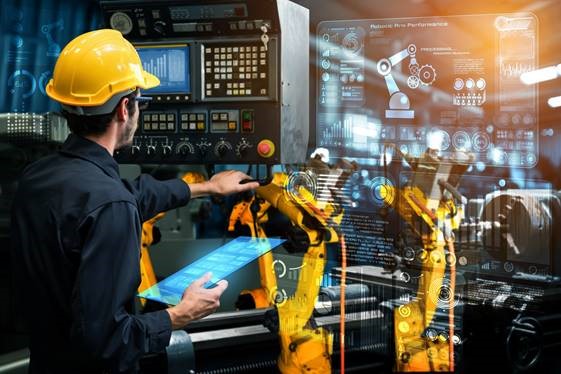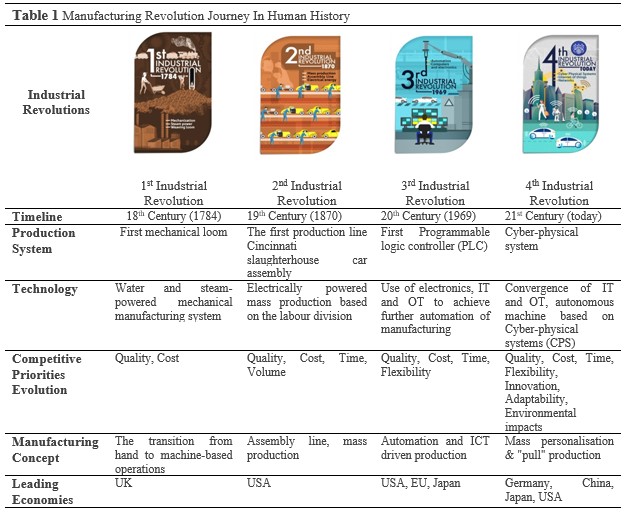SIAA Columnist Part 2 : Industry 4.0: History and Present Time

"The Industrial Revolution was another of those extraordinary jumps forward in the story of civilisation." by Stephen Gardiner
Walk onto the assembly floor of the VinFast car assembly plant in Hai Phong, Vietnam, and immediately, you notice that this is not a traditional manufacturing operation. The general atmosphere is one of quiet, coordinated motion. Yes, you hear the whine of power tools, but mainly, you notice the orderly stacks of parts and the collective movement of humans and machines — 1,200 Swiss-made robots from a renowned manufacturer. You might not notice, but many of the sights and sounds you experience are the results of manufacturing inventions, processes, and ideas developed during the past 270 years. The history of manufacturing technology is a long story, one filled with practical knowledge and social incentives. These drivers led to changes in technology and practices in not one but three earlier industrial revolutions. Now, companies and governments consider the requirements and potential outcomes of a fourth industrial revolution, also known as Industry 4.0. Retracing connections between past ideas, incentives, and production capabilities is valuable for assessing the business and social challenges we are likely to face in Industry 4.0. So, our modus operandi will consider each industrial revolution's big ideas, knowledge, and incentives. Then, we'll see which practices and capabilities emerged from the cauldron of change.
Industry 1.0: Power & Productivity
When we say "the Industrial Revolution," There are many definitions, which go something like this one: "The era of economic and social changes began with the mechanisation of agriculture and manufacturing, at about 1760 in England and later in other countries." Given our society's focus on technological progress, it might be helpful to change the emphasis a bit. By moving our attention from the period to the role of change, our description of Industry 1.0 is the era from 1760 to 1830, typified by steam-powered, factory-based production, in which profound economic and social change became the normal condition. During the period, inventors and investors gradually gather all the production resources at one centralised location, the factory, rather than in scattered places at workers' homes. They started substituting human and water energy with coal-based steam water. This way, they could speed up the manufacturing process by using special-purpose machinery rather than human efforts. The combination of the new energy source and the new way to organise work provided the foundation of Industry 1.0. The development of coal-powered steam technology and the creation of the factory system are the most familiar parts of the early Industrial Revolution. Developments in Industry 1.0 manufacturing emphasised a more robust power source and a more efficient way to organise manufacturing work.
Industry 2.0: Power & Process
The next industrial revolution, Industry 2.0, represented a surge of industrialisation from 1870 to 1914. During this time, manufacturing innovation benefitted from discovering a newer, more potent energy source and new, more efficient manufacturing and post-production methods. During Industry 2.0, the past innovations became the valuable knowledge of the late 19th and early 20th century. When combined with new ideas and economic and social incentives, this knowledge enabled manufacturers to produce consumer and capital goods unprecedentedly. The big pictures driving Industry 2.0 were related to processing and ultimately profit. The phenomenon of electricity was old news—incandescent light bulbs hark back to 1809. However, building a robust infrastructure that delivered safe, reliable electrical power was another matter. That accomplishment came in 1882 when figuring out how to deploy and use electricity in factories required decades more time and effort. Mass production — Steam-powered textile manufacturing made it clear that machines could produce more quickly than human-based production. Mass production became the umbrella term for the high-volume manufacture of products that used standardised parts, techniques, and machinery. Experience with the machine tool industry and creating standardised parts (both late-18th-century innovations) provided sound knowledge that enabled assembly-line mass-production about a century later. Assembly line production — Mass production marked the change from time-consuming, file-and-fit production methods to time-saving assembly methods. Assembly line production was another significant change in manufacturing process design. These improvements aimed to increase production efficiency by minimising the time and effort spent doing each series of tasks. Lower costs not only boosted Ford profits but increased revenues, too. The lower cost of production famously made the Model T accessible to more customers and triggered the automobile age. In the early 20th century, the development of assembly-line production focused on managing the cost, origin, and quality of parts and finished products. Manufacturers started paying attention to supply chains to cut the costs of surplus and shortage of parts.
Industry 3.0: Process Control & Digitisation
In 1968, the development of electronic and IT systems landed the first programmable logic controller (PLC) in Modicon. The advent of the PLC enabled the automation of processes previously controlled by electromechanical devices. This innovation was a significant indicator of Industry 3.0. Before that, the emphasis on manufacturing was on designing and using increasingly more efficient production processes. Since the beginning of Industry 3.0, however, digital process control has become the critical enabler of the next revolutionary surge of manufacturing innovation and productivity. Moving from analogue to digital production process control is the hallmark of the third industrial revolution. Electronics and information technology matured as companies introduced semiconductors and later mainframe and personal computers (PCs). Sometime later, automated manufacturing production processes and supply chains went global. Industry 3.0 manufacturing is part of a familiar world, but its innovations still leave their mark on how we live and work today. The most significant developments came from digital methods of running, automating, and controlling production processes for manufacturing.
The Dawn of Industry 4.0
While the third Industrial Revolution began in the late 1960s, experts debate whether we're still in Industry 3.0 or have moved on to an era of more advanced production methods. Wherever we are in the chronology of industrial development, one thing is sure. Manufacturing process automation enabled by memory-programmable controls and digital technologies has already left its mark on how we produce and distribute goods. More advanced technologies, which automate an entire production process without human assistance, lie in the provisioning of Industry 4.0. This future development will use production systems controlled by computer technology and humans working together. Furthermore, the volume of autonomous production will expand when processes connect via the internet and internet-ready assets. These new systems, which support communication between manufacturing processes and facilities, are the next step in production automation. That means the day of smart factories and fully automated, hands-off manufacturing is possible and might be coming soon.
The figure below shows the development of the various industrial revolution in term of production system, technology, competitive priority and manufacturing concept from the 18th to 21st century.

About the Columnist
Industry veteran Colin Koh is our monthly columnist to share with SIAA community the essence of ASEAN manufacturing and pragmatic tips on how to approach and navigate the fourth industrial revolution for their businesses. Stay tune to Colin's regular segment all about Smart Manufacturing 4.0 in ASEAN! Please visit www.asean4ir.com more resource.
